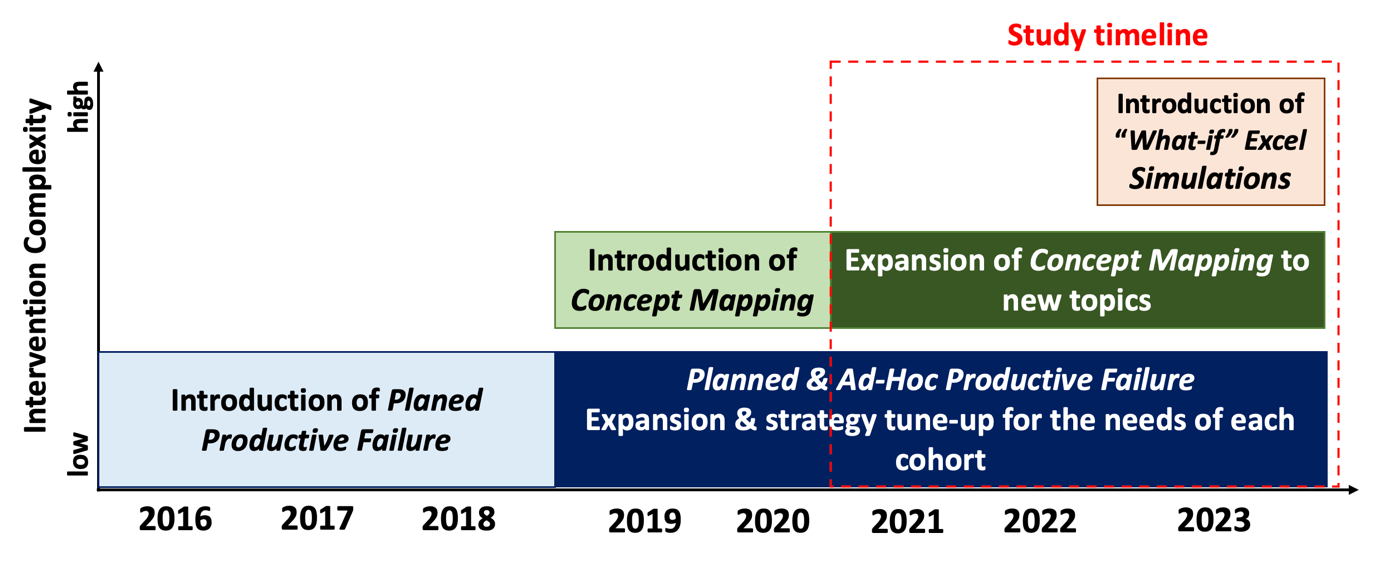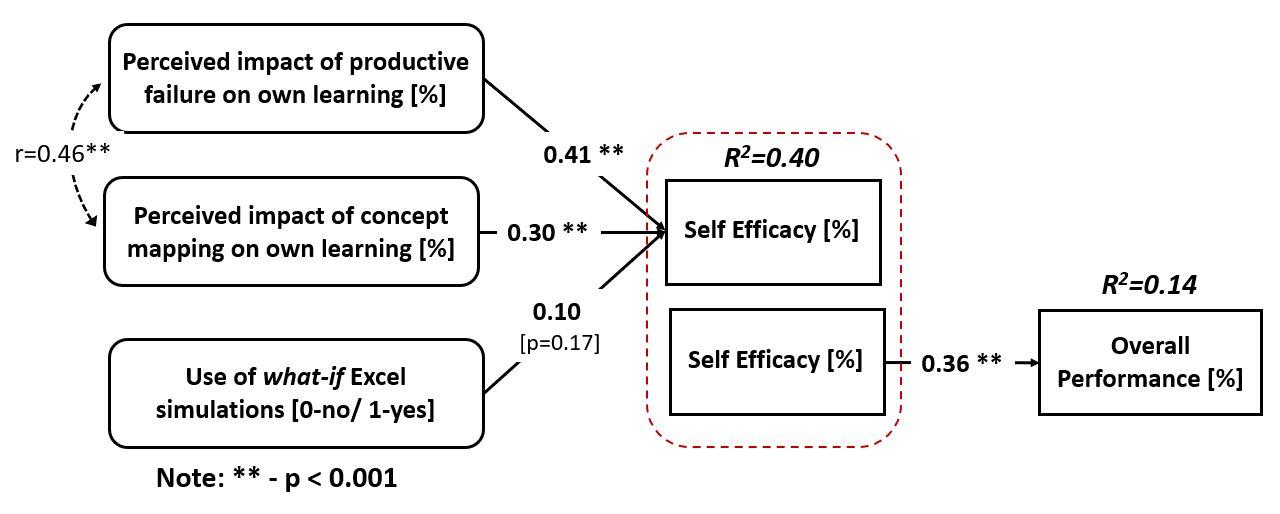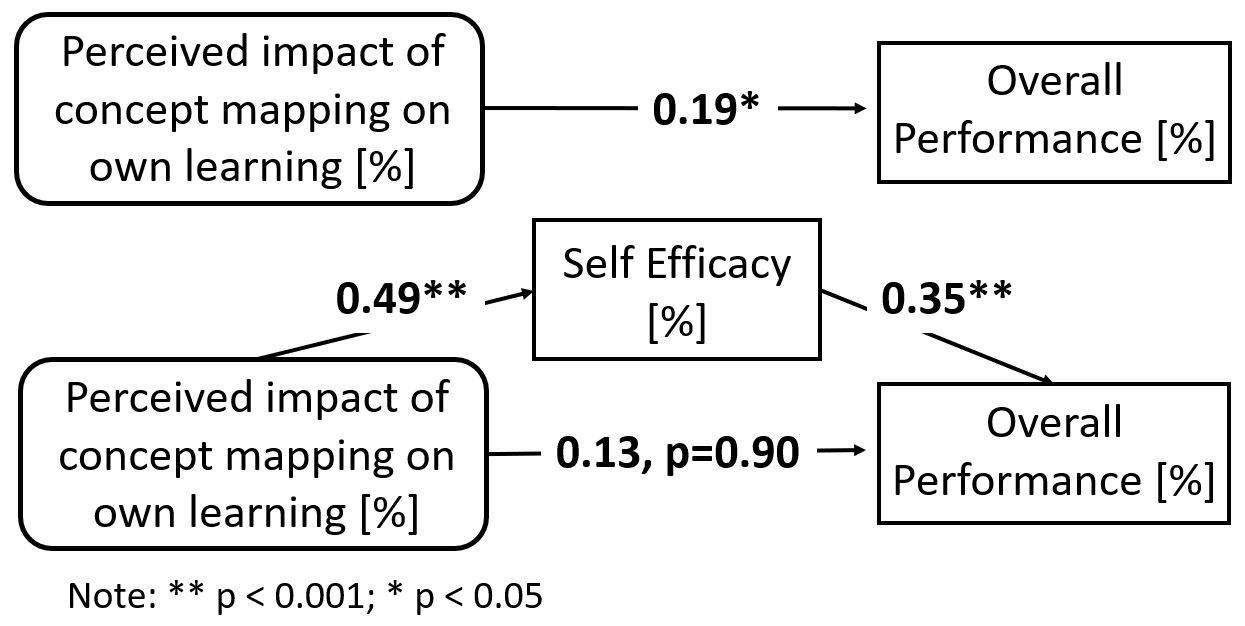Accrediting agencies mandate pharmacy doctoral programs to equip future pharmacists with essential transferable skills to manage increasingly complex healthcare tasks. The objective of this study was to evaluate the impact of three adaptive expertise strategies—productive failure, concept mapping, and what-if Excel simulations—on students' self-efficacy beliefs and performance in an introductory pharmaceutics course. The research included student cohorts from 2019 to 2023.
This study used adaptive expertise and self-efficacy as its conceptual framework. As proposed by Hatano and Inagaki (1986), adaptive expertise expands the learning process from procedural knowledge, which explains how something works, to conceptual knowledge, which explains why something works. While procedural knowledge are useful for routine tasks, conceptual skills are transferable to new contexts. Steenhof (2020) suggested three critical strategies for implementing adaptive expertise in the classroom: engagement in why questions, struggle in a safe environment, and exposure to what-if questions.
Self-efficacy, introduced by Bandura (1977) as core concept of social cognitive theory, is modeling human agency through individuals’ beliefs in their ability to achieve goals and perform tasks (Bandura, 1989). Since self-efficacy is influenced by past performance, modeling, and feedback, it will likely be impacted by the learner’s engagement in adaptive expertise instructional strategies. Prior research has shown that self-efficacy enhances academic motivation (Schunk, 1991) and is positively related to transfer generalization and maintenance in professional training (Burke & Hutchins, 2007), key outcomes of adaptive expertise instruction. Thus, self-efficacy complements the adaptive expertise model in analyzing the impact of the instructional interventions implemented in this study.
Pharmaceutics I is a foundational Doctor of Pharmacy (PharmD) course which helps first-year (P1) pharmacy students connect foundational chemistry from their pre-pharmacy courses with applied chemistry needed in clinical courses. The main focus of this course is to help PharmD students develop transferable problem-solving skills.
Multiple cohorts of P1 students at a Midwestern university participated in a Pharmaceutics I course which used a combination of instructional strategies to build adaptive expertise skills (e.g., Hatano & Inagaki, 1986; Steenhof, 2020). The instructor collaborated with an instructional designer to implement three key strategies: productive failure, concept mapping, and what-if Excel simulations. These strategies align with the critical techniques proposed by Steenhof (2020) to foster adaptive expertise in the classroom.
First, productive failure creates a safe environment for students to struggle and learn from their failures (Kapur, 2008). This strategy, introduced between 2016 and 2018, focused on helping students connect the conceptual aspects of chemical structures with corresponding algebraic equations. Students engaged in productive failure during this period outperformed their counterparts from previous cohorts (Cernusca & Mallik, 2018). From 2019 to 2024, productive failure was expanded and further tailored to the needs of each cohort. Additionally, in 2022, an ad-hoc form of productive failure was tested to support problem-solving skills beyond the initial topics. Students were guided to collaboratively solve challenging problems by using scaffolding instructions provided by the instructor.
Second, in 2019, the instructor introduced structural concept maps as part of worked examples. Concept mapping, a mindtool which helps learners answer why questions (Jonassen, 2000), targeted students’ lack of ability to analyze the structural chemistry concepts to decide on the appropriate analysis. These maps modeled the instructor’s thinking process and were used to solve in-class problems, homework, and exams, complementing the productive failure strategy (Cernusca & Mallik, 2022). The positive impact of structural concept maps on students' self-efficacy and their feedback convinced the instructor to expand their use across multiple types of problems.
Finally, in 2023, the instructor introduced in-class what-if Excel simulations to help students grasp acid-base drug solutions and sedimentation rates of particles in suspensions. These simulations allowed students to manipulate a set of given variables and observe outcomes graphically. They promoted cognitive flexibility by exposing students to multiple perspectives of the same phenomenon (Jonassen, 2000). For instance, one simulation enabled students to select different concentrations of acidic drug solutions and visualize pH variations for various drugs with given acidity constants (pKa). These simulations were used only in lectures but were made available to students for exam preparation.
The combined use of productive failure, concept mapping, and what-if simulations effectively supported the development of adaptive expertise in Pharmaceutics I, equipping students with the skills needed for coursework in therapeutics. Figure 1 summarizes the integration timeline and highlights the research timeline. The proposed timeline captures each strategy at a different stage from full implementation to expansion and introduction.
Figure 1
Stages of Integration of Instructional Strategies Focused on Building Adaptive Expertise Skills

This study utilized an exploratory quantitative research design to investigate two key areas: (a) the evolution of students' epistemic beliefs following the implementation of complementary adaptive expertise strategies, and (b) the relationships between self-efficacy, the perceived impact of these strategies (productive failure, concept mapping, and what-if Excel simulations), and overall course performance.
An online exit survey was administered each semester to collect data. The constructs for self-efficacy (Cernusca & Price, 2013) and the perceived impact on learning of productive failure and concept mapping (Grasman & Cernusca, 2015) were adapted from the literature. These constructs demonstrated strong internal reliability, with Cronbach's Alpha scores between 0.92 and 0.96. To ensure consistency across different evaluation scale dimensions used in the study, mean construct scores were converted to percentages of the maximum evaluation scale score. Overall student performance was also recorded as a percentage. A dummy variable (0 = not used, 1 = used) was introduced to capture the impact of what-if simulations.
A convenience sampling strategy was used, inviting all students from the 2021 (N = 54), 2022 (N = 55), and 2023 (N = 50) cohorts to participate voluntarily. Participation rates were 91% for the 2021 cohort, 89% for the 2022 cohort, and 50% for the 2023 cohort. An independent-sample t-test comparing participants' performance with the whole class performance revealed no significant differences. Therefore, the convenience samples represented their respective cohorts regarding the course performance.
A one-way ANOVA revealed an increase in mean self-efficacy scores across the three cohorts from 81.5% to 87.4%. However, this increase was not statistically significant. Similarly, the perceived impacts of productive failure and concept mapping did not differ significantly across cohorts.
Correlational analysis showed moderate to high significant correlations between self-efficacy and the perceived impacts of productive failure and concept mapping (see Table 1). Additionally, there was a moderate significant correlation between the perceived impact of productive failure and concept mapping, and a weak to moderate significant correlation between self-efficacy and overall course performance.
Table 1
Basic statistics and Pearson correlations
Variable | Mean (SD) [%] | (2) | (3) | (4) | (5) |
|---|---|---|---|---|---|
(1) Productive Failure Impact | 80.64 (16.64) | 0.46** | 0.18* | 0.57** | 0.14 |
(2) Concept Mapping Impact | 78.45 (17.91) | - | -0.02 | 0.47** | 0.19* |
(3) Use of What-If Excel Simulations | - | - | 0.17 | 0.21* | |
(4) Self-Efficacy | 82.59 (14.10) | - | 0.36** | ||
(5) Overall course performance | 89.22 (5.52) | - |
** Correlation is significant at the 0.01 level (2-tailed)
* Correlation is significant at the 0.05 level (2-tailed)
Two regression analyses suggested self-efficacy might mediate the relationship between certain instructional intervention variables and overall student performance (Figure 2). Given the significant moderate correlation between the perceived impact of productive learning and concept mapping, a moderation analysis was performed following Baron and Kenny's (1986) four-step approach.
Figure 2
Regression analyses synthesis

The perceived impact of concept mapping was the only independent variable meeting all criteria for mediation analysis at p<0.05. The analysis showed that self-efficacy fully mediated the relationship between the perceived impact of concept mapping and overall performance (see Figure 3).
Figure 3
Synthesis of self-efficacy mediation analysis for perceived impact of concept mapping

As shown in Table 1, the introduction of what-if Excel simulations increased students’ self-efficacy from 81.4% to 87.7%, but was not a significant predictor of self-efficacy (p = 0.054). Nevertheless, a multiple-choice question revealed that 56% of the 2023 cohort found these simulations useful to extremely useful (Figure 4). This suggests the potential for what-if Excel simulations to become a significant predictor of self-efficacy once fully implemented.
Figure 4
Students’ perceptions about the usefulness of what-if Excel Simulations

The findings from this study indicate the fully implemented strategies, particularly productive failure and structural concept mapping, significantly predict self-efficacy, highlighting their potential to foster strong conceptual knowledge and transferable skills, as outlined by the adaptive expertise model. While productive failure significantly predicted self-efficacy, it did not predict final course performance. This outcome can be attributed to its early integration into the course and its narrow scope across topics. In contrast, structural concept mapping was a significant predictor of both self-efficacy and overall performance, likely due to its comprehensive implementation and broader application across course topics. The newly introduced what-if Excel simulations showed lower immediate impact on self-efficacy but demonstrated potential for complementing the effectiveness of the other strategies once fully integrated.
The main limitations of this study include its focus on a single course with a relatively small sample sizes across the implementation timeline. Additionally, the what-if Excel simulations were not fully implemented at the time of the study.
Future research should investigate the fully implemented what-if Excel simulations' impact on self-efficacy and performance. Further research should also explore the transferability of adaptive expertise skills developed in this course to subsequent therapeutic courses that require this course as a prerequisite.